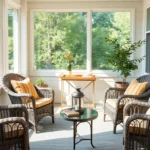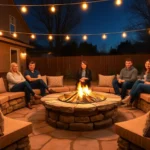We’ve all felt that irresistible pull to spend more time outdoors – especially when our indoor spaces start feeling cramped or stale. Outdoor living rooms are transforming how we think about our homes by seamlessly blending comfort with nature’s beauty. These thoughtfully designed spaces aren’t just patios with furniture thrown together; they’re fully functional extensions of our homes that rival any indoor room.
The concept has exploded in popularity as we’ve discovered the incredible benefits of fresh air living. From cozy fire pit gatherings to elegant dining under the stars outdoor living rooms offer endless possibilities for relaxation and entertainment. We’re seeing homeowners create everything from rustic retreat corners to sophisticated spaces that feel like five-star resort lounges.
Whether you’re working with a sprawling backyard or a compact balcony we’ll show you how to design an outdoor living room that perfectly matches your lifestyle and budget. It’s time to unlock your property’s potential and create the outdoor oasis you’ve been dreaming about.
Define Your Outdoor Living Room Style and Theme
Choosing the right aesthetic foundation sets the stage for creating an outdoor space that truly reflects your personality and complements your home’s architecture.
Modern Minimalist Outdoor Spaces
Clean lines and neutral colors create the backbone of contemporary outdoor design. We recommend focusing on sleek furniture pieces with geometric shapes and materials like brushed aluminum, teak, or powder-coated steel. Monochromatic color schemes using whites, grays, and blacks provide a sophisticated backdrop that won’t compete with natural surroundings.
Furniture selection emphasizes function over ornamentation in minimalist designs. Choose streamlined seating options such as modular sectionals, platform daybeds, or cantilever chairs that offer comfort without visual clutter. Simple planters with architectural plants like ornamental grasses, succulents, or boxwood hedges maintain the uncluttered aesthetic.
Lighting fixtures should complement the minimal approach with subtle elegance. Install recessed LED strip lights under seating areas, pendant lights with clean glass shades, or geometric floor lamps that double as sculptural elements. These choices create ambiance while maintaining the space’s sophisticated simplicity.
Rustic and Natural Design Elements
Organic materials bring warmth and authenticity to outdoor living spaces. We suggest incorporating reclaimed wood furniture, natural stone accents, and wrought iron details that develop beautiful patina over time. Cedar, teak, and weathered pine create inviting seating areas that blend seamlessly with garden environments.
Textural variety adds visual interest while maintaining the natural theme. Layer different materials such as woven rattan cushions, jute rugs, and linen upholstery that can withstand outdoor conditions. Natural fiber throws and pillows in earthy tones like terracotta, sage green, and warm browns enhance the cozy atmosphere.
Plant choices should emphasize native species and cottage garden favorites. Select flowering perennials, herb gardens, and climbing vines that attract beneficial insects and create seasonal interest. Wooden planters, galvanized metal containers, and ceramic pots in muted tones complement the rustic aesthetic without overwhelming the space.
Mediterranean Inspired Outdoor Rooms
Warm color palettes and traditional craftsmanship define this timeless design approach. We recommend using terra cotta tiles, natural stone pavers, and stucco walls in warm whites or soft yellows that reflect the Mediterranean climate. Wrought iron furniture with curved details and mosaic accents add authentic character to the space.
Architectural elements create intimate gathering areas reminiscent of European courtyards. Install pergolas with climbing bougainvillea, jasmine, or grapevines that provide natural shade and fragrance. Low walls, decorative fountains, and arched doorways establish distinct zones while maintaining an open, flowing layout.
Textile choices should embrace rich textures and vibrant patterns. Choose outdoor fabrics in deep blues, sunny yellows, and warm oranges that capture the Mediterranean spirit. Striped awnings, patterned cushions, and woven market umbrellas add comfort while protecting against sun exposure.
Choose the Perfect Location for Your Outdoor Living Room

Finding the right spot for your outdoor living room sets the foundation for everything else. We’ll help you evaluate key factors that’ll make your space both functional and enjoyable.
Assessing Your Yard’s Natural Features
Existing landscaping plays a crucial role in determining where your outdoor living room should go. Beautiful mature trees can provide natural shade and privacy while water features like fountains or ponds create soothing background sounds. Gardens with established flower beds add color and fragrance to your space.
Slope and drainage require careful evaluation before you start building. Level ground prevents furniture from wobbling and makes the space more comfortable for guests. Poor drainage leads to puddles after rain and can damage furniture or create muddy conditions that make your outdoor room unusable.
Existing structures like patios and decks offer ready-made foundations for your outdoor living room. Pergolas provide natural framework for hanging lights or climbing plants. These features save money and create seamless connections between your indoor and outdoor spaces.
Considering Sun and Shade Patterns
Sun exposure changes throughout the day and affects how comfortable your outdoor living room feels. Morning sun creates pleasant breakfast spots while afternoon shade prevents overheating during peak hours. We recommend observing your yard at different times to identify the best positioning for seating areas.
Shade options become essential for year-round enjoyment of your outdoor space. Trees offer natural cooling and seasonal beauty as leaves change colors. Awnings provide adjustable protection from both sun and light rain. Pergolas with climbing vines like grape or wisteria create living canopies that improve over time.
Evaluating Privacy and Noise Factors
Privacy transforms your outdoor living room from a public display into an intimate retreat. Screens made from bamboo or fabric panels block sightlines from neighboring properties. Hedges like boxwood or privet grow into natural walls that also reduce wind. Fencing options include wood panels or decorative metal that complement your home’s architecture.
Noise considerations help determine which areas of your yard work best for conversation and relaxation. Traffic sounds from nearby streets can overwhelm quiet discussions. Neighbor activities like lawn mowing or children playing might interrupt peaceful moments. Sound barriers such as water features or dense plantings help mask unwanted noise while creating pleasant ambient sounds.
Select Durable and Weather-Resistant Furniture

Choosing the right materials for your outdoor living room furniture makes the difference between enjoying your space for years or replacing pieces after just one season. Materials like aluminum, teak wood, all-weather wicker, stainless steel, and HDPE offer superior resistance to weather conditions while maintaining their style and functionality.
All-Weather Seating Options
Synthetic wicker and rattan provide exceptional durability compared to their natural counterparts while delivering that coveted bohemian aesthetic we’re all drawn to. These materials resist fading, cracking, and moisture damage that typically destroys traditional wicker pieces within a few seasons.
Aluminum seating frames offer lightweight portability without sacrificing strength, making them perfect for spaces where you’ll need to rearrange furniture frequently. Powder coating on aluminum pieces provides additional UV protection that prevents color fading and maintains that fresh appearance year after year.
Teak wood seating naturally repels water, insects, and decay thanks to its inherent oils, eliminating the need for constant maintenance treatments. Premium teak pieces develop a beautiful silver patina over time that many homeowners actually prefer to the original golden tone.
Outdoor Coffee Tables and Side Tables
Aluminum coffee tables and side tables require minimal maintenance while offering easy cleaning with just soap and water. These pieces resist rust formation even in coastal environments where salt air typically accelerates metal corrosion.
Weather resistant materials ensure your tables maintain both functionality and visual appeal through countless seasons of use. Stainless steel options provide industrial elegance while withstanding extreme temperature fluctuations without warping or cracking.
HDPE tables offer the appearance of traditional wood without the maintenance headaches, as this material won’t splinter, rot, or require annual staining treatments.
Storage Answers for Outdoor Cushions
Waterproof storage bins protect your cushions from rain and UV exposure when not in use, significantly extending their lifespan beyond typical outdoor fabric expectations. Dedicated cushion covers create an additional layer of protection while allowing you to keep cushions on furniture during light weather.
Regular cleaning combined with proper storage prevents mold and mildew growth that often ruins outdoor textiles within a single humid season. Investing in quality storage answers costs far less than replacing cushions annually due to weather damage.
Ventilated storage options prevent moisture buildup while keeping cushions dry and fresh for your next outdoor gathering.
Create Comfortable Seating Areas and Zones
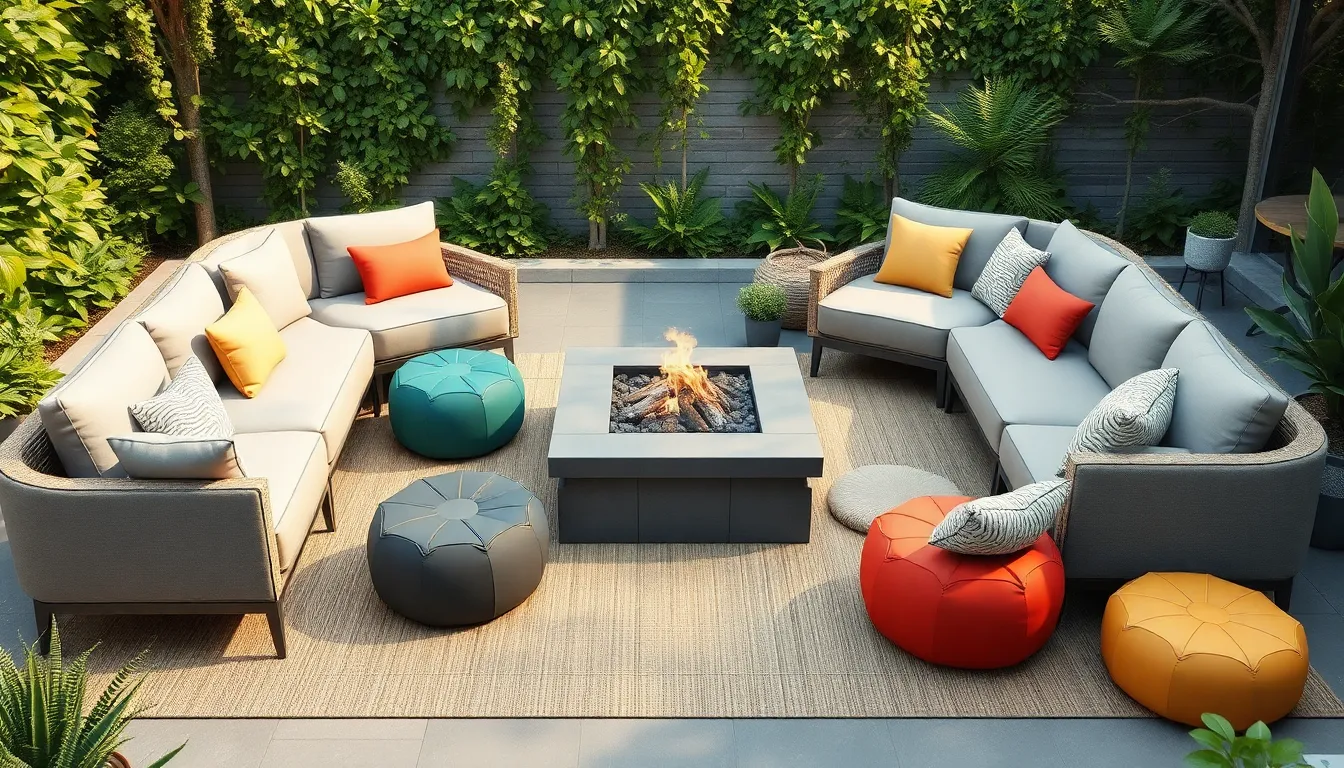
Now that we’ve selected durable furniture, let’s focus on creating purposeful zones that transform your outdoor space into a functional living room. Strategic zoning makes even small patios feel spacious while serving multiple purposes throughout the day.
Arranging Furniture for Conversation
Position furniture in U-shaped or circular layouts around a central feature like a coffee table or fire pit to naturally draw people together. This arrangement facilitates conversation by ensuring everyone can see and interact with each other comfortably.
Choose sectionals, chairs with ottomans, and loveseats to promote both comfort and sociability in your outdoor living room. These seating options encourage guests to settle in for longer conversations while providing adequate support.
Avoid lining furniture against walls as this setup limits engagement and detracts from the cozy atmosphere you’re trying to create. Instead, float furniture pieces to establish intimate conversation circles that feel inviting.
Center seating around focal points such as fire pits for gatherings or designate quiet corners specifically for relaxation. These defined zones help establish the purpose of each area within your outdoor living space.
Adding Outdoor Rugs for Warmth
Define seating areas with weather-resistant outdoor rugs that add visual warmth and comfort to your space. Rugs create clear boundaries between different zones while providing a soft surface underfoot that makes the area more inviting.
Select durable materials specifically designed for outdoor conditions to ensure your rugs withstand weather exposure. These materials resist fading, mold, and moisture while maintaining their appearance throughout the seasons.
Protect deck and patio surfaces with rugs that also absorb sound, creating a quieter, more comfortable environment for conversation. This dual function enhances both the aesthetic and practical aspects of your outdoor living room.
Incorporating Flexible Seating Options
Add poufs, ottomans, and movable chairs to allow easy reconfiguration based on group size or exact activities. These versatile pieces ensure your outdoor living room adapts seamlessly to different entertaining needs.
Include benches and modular seating that can accommodate additional guests without overcrowding the main seating area. This flexibility proves invaluable when hosting larger gatherings or intimate conversations.
Mix various seating types to ensure both comfort and practicality for different occasions throughout the year. This approach creates ever-changing arrangements that serve both everyday relaxation and special entertaining needs effectively.
Install Proper Lighting for Evening Ambiance
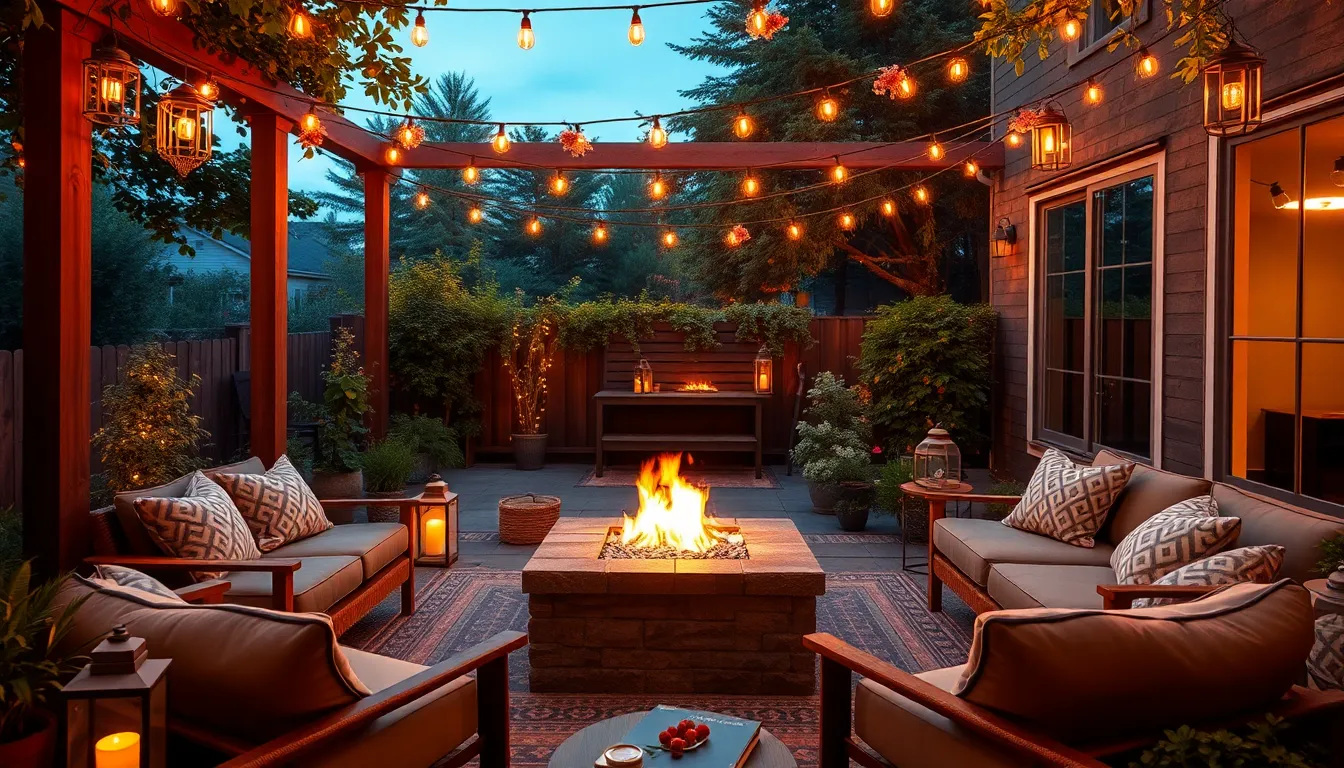
Creating the perfect lighting transforms our outdoor living rooms from daytime retreats into magical evening sanctuaries. Layering task, ambient, and accent lighting allows us to customize illumination for different activities like dining, entertaining, or quiet relaxation.
String Lights and Overhead Lighting
String lights instantly create a festive and inviting atmosphere that makes our guests feel welcome. We can drape them above seating areas, along pergolas, or wrap them around trees and railings for maximum visual impact. Installing these versatile lights requires minimal effort while delivering stunning results.
Overhead lighting options like pendant lights or chandeliers mounted to pergolas provide substantial illumination and serve as striking decorative focal points. Positioning these fixtures strategically ensures we have adequate light for evening activities while maintaining the cozy ambiance we desire. Combining string lights with overhead fixtures creates ever-changing lighting layers that adapt to our changing needs.
Solar-Powered Lighting Answers
Solar-powered lights offer an eco-friendly and cost-effective solution that eliminates the need for complex wiring. These lights automatically illuminate as the sun sets, providing consistent lighting without increasing our electricity bills. Available options include string lights, pathway lights, and spotlights that suit various outdoor living room layouts.
Installing solar fixtures works perfectly for areas removed from power sources or when we want to embrace sustainable living practices. Modern solar technology delivers reliable performance that matches traditional electric lighting while reducing our environmental footprint. Weather-resistant designs ensure these lights withstand outdoor conditions year after year.
Fire Features and Lanterns
Fire features like fire pits, outdoor fireplaces, and chimineas provide both warmth and ambient light that extends our outdoor season into cooler months. These installations create natural gathering points where family and friends gravitate for conversation and connection. Combining heat and illumination makes these features especially valuable for year-round outdoor enjoyment.
Lanterns powered by batteries, candles, or solar energy offer flexible and portable illumination we can arrange based on our exact needs. Placing them on tables or hanging them from hooks allows us to adjust lighting levels throughout the evening. Battery-powered and solar lanterns eliminate fire safety concerns while still providing that warm, flickering glow that creates a cozy atmosphere.
Add Shelter and Shade Elements
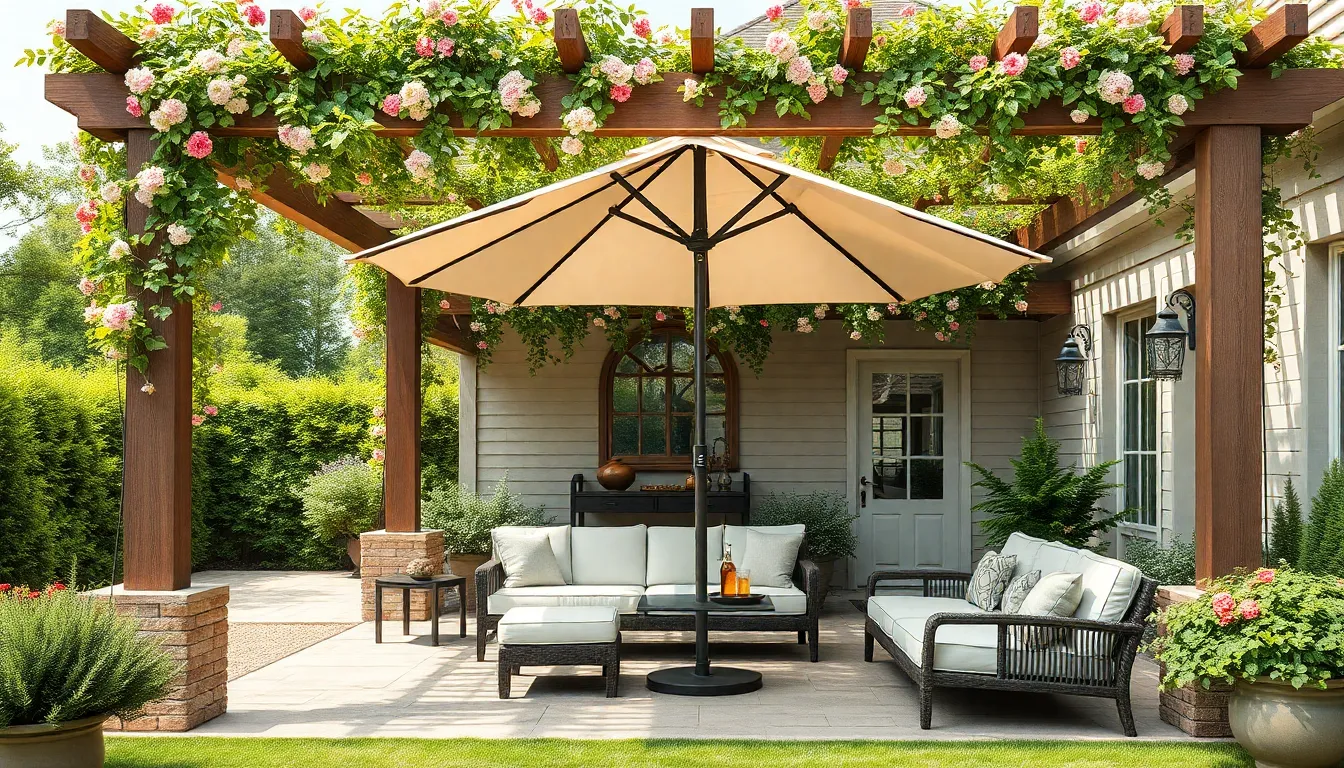
Creating comfortable outdoor living rooms requires incorporating shelter and shade elements that protect from sun and rain while improving your space’s visual appeal. These structural additions transform open patios into cozy, functional retreats perfect for year-round enjoyment.
Pergolas and Gazebos
Pergolas offer an elegant solution for partial shade and vertical definition in outdoor spaces. These structures feature columns or posts supporting an open roof design that creates beautiful shadow patterns throughout the day. Climbing plants like jasmine, wisteria, or grape vines can be trained over pergola roofs to provide additional natural coverage and visual interest.
Gazebos provide more comprehensive protection with their freestanding design and solid roof construction. We recommend gazebos for areas where you need full shade and weather protection, making them ideal for dining areas or reading nooks. Their enclosed structure creates an intimate atmosphere while offering complete shelter from rain and intense sunlight.
Both options serve as stunning architectural focal points that define your outdoor living room’s boundaries while maintaining an open, airy feel.
Retractable Awnings and Umbrellas
Retractable awnings deliver maximum flexibility for controlling sun and rain exposure throughout the day. These motorized or manual systems extend when you need coverage and retract completely when you want full sun exposure. We suggest choosing awnings with wind sensors and weather-resistant fabrics that can withstand seasonal elements.
Umbrellas provide instant, portable shade that adapts to your changing needs. Large cantilever umbrellas work exceptionally well for covering multiple seating areas, while smaller market umbrellas suit intimate dining settings. We recommend selecting umbrellas with weighted bases and tilting mechanisms that allow you to follow the sun’s movement throughout the day.
Both answers offer immediate shade without permanent structural changes to your outdoor space.
Natural Shade from Trees and Landscaping
Strategically planted trees create the most sustainable and cost-effective shade answers for outdoor living rooms. Deciduous trees like maples, oaks, or flowering cherries provide summer shade while allowing winter sunlight to filter through bare branches. We suggest planting trees 15-20 feet from seating areas to ensure adequate coverage without overwhelming the space.
Dense landscaping using shrubs, tall grasses, and layered plantings creates natural windbreaks and shaded microclimates. Bamboo screens, evergreen hedges, or ornamental grasses can block harsh afternoon sun while adding privacy and visual texture. Native plants require less maintenance and provide better habitat for local wildlife, making them environmentally conscious choices for natural shade answers.
These living shade elements improve over time, becoming more effective as plants mature and establish their root systems.
Incorporate Outdoor Entertainment Features
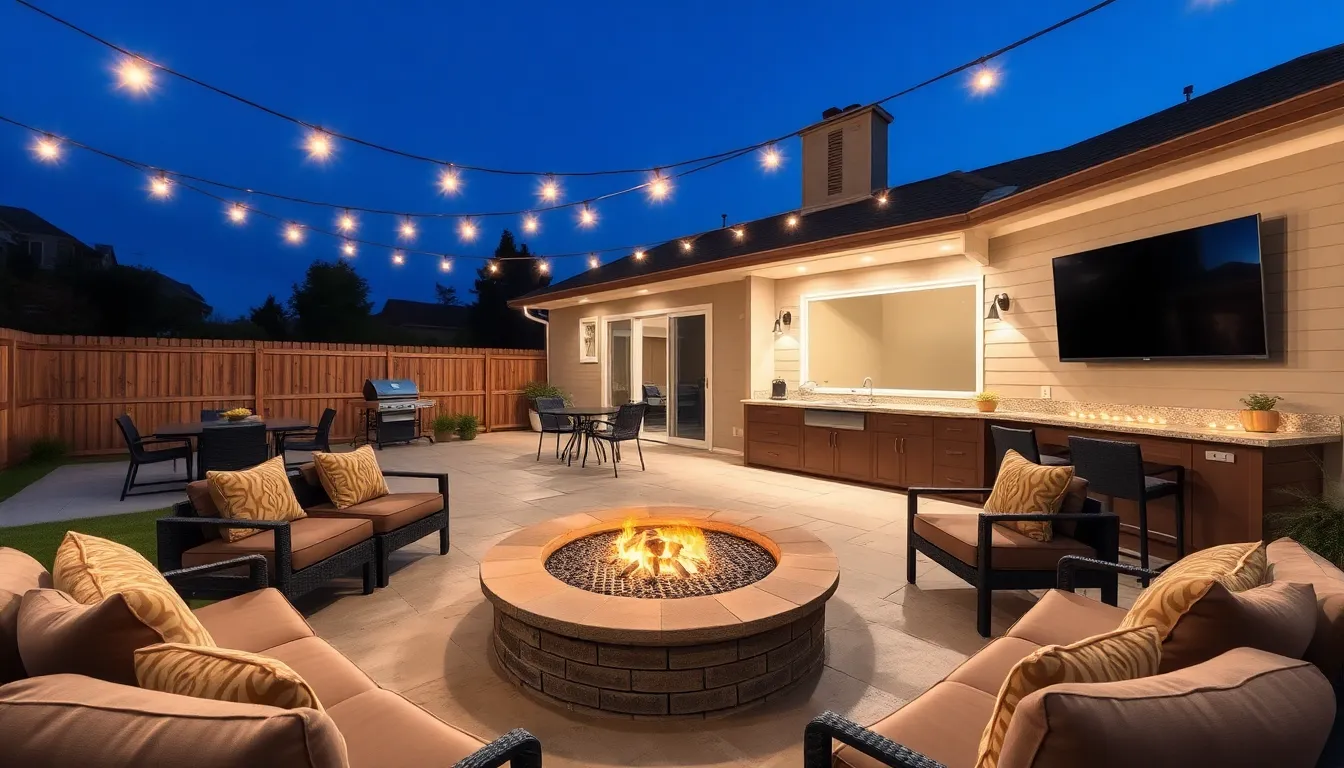
Modern outdoor living rooms truly shine when we integrate entertainment features that rival our indoor spaces. These elements transform our backyard retreats into ever-changing venues for relaxation and social gatherings year-round.
Outdoor Sound Systems and TVs
Weather-resistant sound systems bring our favorite music and audio experiences directly to our outdoor spaces. We recommend selecting equipment specifically designed to withstand moisture, temperature fluctuations, and UV exposure while maintaining exceptional sound quality. Strategically placed speakers create immersive audio zones that complement our seating arrangements without overwhelming conversation areas.
Outdoor TVs elevate our entertainment options by enabling movie nights, sports viewing, and streaming content under the stars. These specialized displays feature enhanced brightness levels and weatherproof construction that performs reliably in various outdoor conditions. We suggest mounting TVs at optimal viewing angles that accommodate multiple seating positions while protecting screens from direct sunlight and precipitation.
Integrated entertainment systems seamlessly connect our indoor and outdoor audio-visual experiences through wireless technology. Smart home integration allows us to control music, lighting, and temperature from our smartphones while entertaining guests. This connectivity creates cohesive entertainment environments that flow naturally between our interior and exterior living spaces.
Fire Pits and Outdoor Fireplaces
Fire features serve as natural gathering points that extend our outdoor season well into cooler months. Statistics show that 73% of architects and homebuilders now incorporate fire elements into outdoor spaces, highlighting their popularity and functional value. These installations provide warmth, ambiance, and focal points that encourage conversation and relaxation around crackling flames.
Modern fire pit designs range from portable bowl styles to custom-built installations that complement our outdoor decor. Gas fire pits offer convenient operation with adjustable flame control, while wood-burning options provide authentic crackling sounds and aromatic experiences. We can choose from materials like copper, stone, steel, and concrete to match our design aesthetic and durability requirements.
Outdoor fireplaces create dramatic architectural statements while providing substantial warmth for larger gathering areas. These permanent installations can incorporate storage for firewood, integrated seating, and decorative elements like mantels or stone surrounds. Sculptural fire features add artistic flair while serving practical heating purposes, making them excellent investments for outdoor entertainment spaces.
Outdoor Kitchen and Bar Areas
Outdoor kitchens rank among the most desired features, with 68% of professionals emphasizing their inclusion in modern outdoor living designs. These fully equipped cooking spaces eliminate the need to constantly travel between indoor kitchens and outdoor entertaining areas. We can install grills, sinks, refrigeration units, and prep surfaces that rival our indoor culinary setups.
Bar areas create dedicated spaces for beverage service and casual dining that encourage social interaction. Built-in bars with storage, ice makers, and wine coolers provide convenience while maintaining clean, organized appearances. Counter seating allows guests to interact with hosts during meal preparation, creating captivating experiences that blend cooking and entertaining.
Complete outdoor kitchen islands combine cooking, storage, and serving functions in cohesive units that maximize efficiency. These installations can include pizza ovens, smokers, warming drawers, and dishwashers that support elaborate outdoor dining experiences. Weather-resistant cabinetry and countertops ensure long-lasting performance while maintaining attractive appearances through seasonal changes.
Enhance with Plants and Landscaping
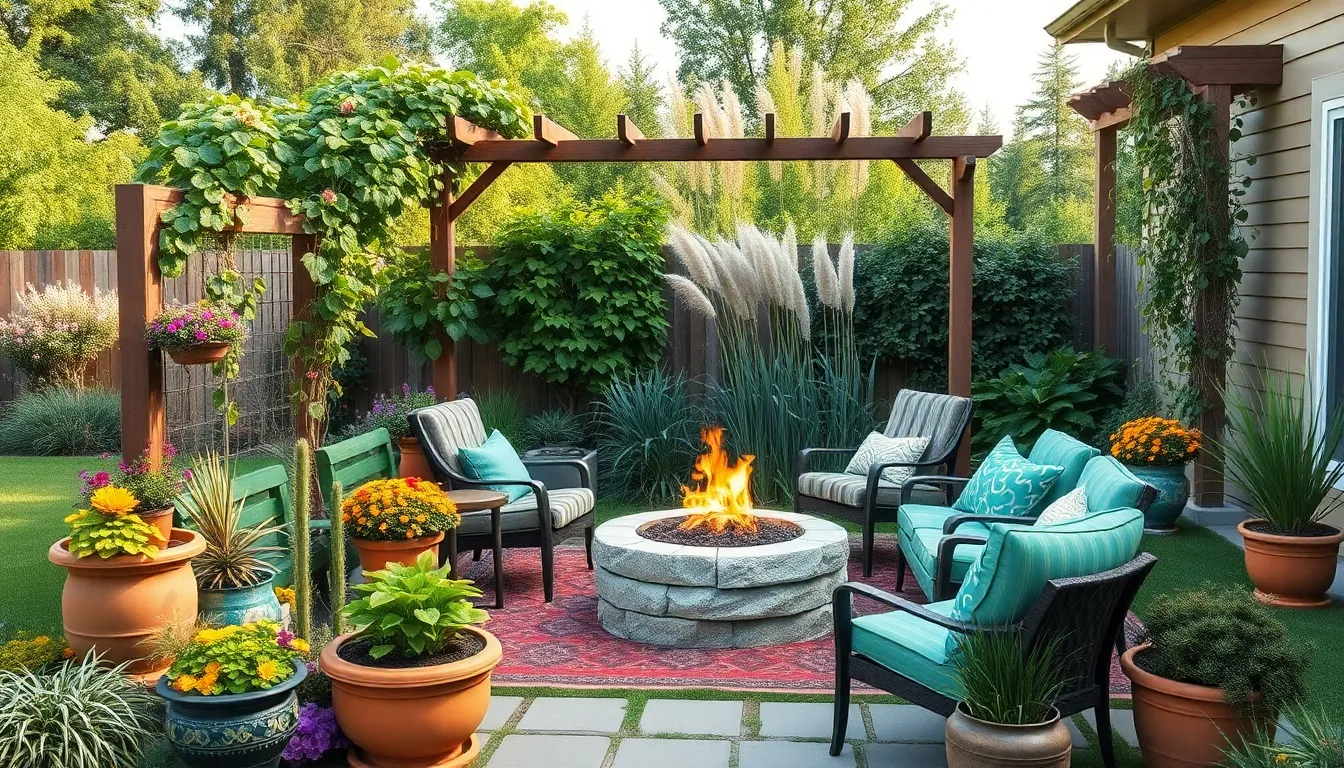
Plants and landscaping elements transform outdoor living rooms into vibrant, inviting spaces that seamlessly blend comfort with natural beauty. We’ll explore strategic approaches to incorporating greenery that enhances both privacy and aesthetic appeal.
Container Gardens and Planters
Container gardens provide exceptional flexibility when designing our outdoor living spaces. We can easily rearrange planters to accommodate different seating configurations or seasonal design changes, making them perfect for adapting to various entertaining needs.
Strategic placement of large planters helps frame seating areas and create natural boundaries between different zones. Elevated planters work particularly well for defining dining spaces, while ground level containers can anchor conversation areas around fire pits or coffee tables.
Seasonal versatility becomes effortless with container gardening since we can swap out plants throughout the year. Spring bulbs can transition to summer annuals, then autumn mums, allowing our outdoor rooms to maintain visual interest across all seasons.
Size variety in planters creates visual depth and prevents monotonous arrangements. Large statement planters anchor corners and entry points, while smaller containers can cluster together to form interesting vignettes on side tables or plant stands.
Privacy Screens with Greenery
Living privacy screens offer superior benefits compared to traditional fencing by providing seclusion while maintaining natural beauty. Climbing vines on trellises create vertical gardens that block unwanted views without completely closing off our spaces.
Evergreen options like ivy, clematis, or jasmine ensure year round coverage and privacy. These climbing varieties establish quickly and provide dense foliage that effectively screens neighboring properties or busy streets from our outdoor living areas.
Layered screening combines different plant heights to create comprehensive privacy barriers. Tall ornamental grasses paired with medium shrubs and climbing vines establish multiple levels of coverage that feel more natural than single height plantings.
Fragrant varieties add sensory appeal to our privacy answers by incorporating plants like honeysuckle or confederate jasmine. These aromatic options enhance the overall ambiance of our outdoor rooms while serving their practical screening function.
Low-Maintenance Plant Selection
Drought tolerant plants ensure our outdoor living rooms remain beautiful without demanding excessive watering or care. Succulents like agave, sedum, and echeveria thrive in containers and require minimal attention while providing striking architectural forms.
Native plant choices adapt naturally to local climate conditions and support regional wildlife populations. These varieties typically require less water, fertilizer, and pest control than non native alternatives, making them ideal for busy homeowners.
Hardy perennials return year after year with minimal intervention, providing consistent color and texture. Plants like lavender, ornamental grasses, and daylilies establish strong root systems that withstand weather fluctuations while delivering reliable performance.
Evergreen shrubs maintain structure and color throughout all seasons without requiring replanting or important maintenance. Boxwood, holly, and dwarf conifers provide permanent backbone plantings that anchor our outdoor room designs while demanding minimal care.
Protect Your Investment with Proper Maintenance
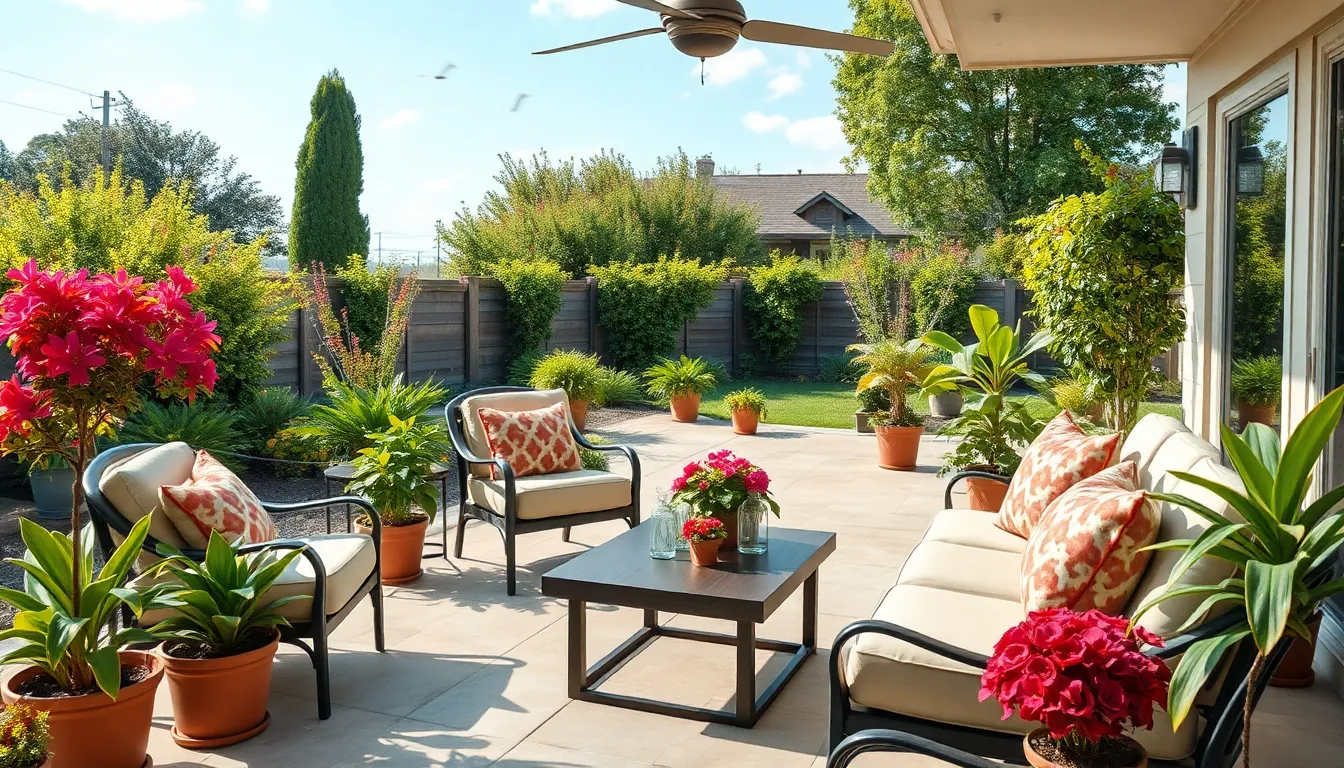
Our outdoor living rooms represent important investments that require consistent care to maintain their beauty and functionality. Regular maintenance safeguards these valuable spaces from weather damage while ensuring years of enjoyment.
Seasonal Furniture Care and Storage
Inspect furniture thoroughly at the beginning of each season to identify rust, mildew, or structural issues before they worsen. We recommend checking all joints, bolts, and connections to ensure everything remains secure and stable.
Clean surfaces regularly using mild soap and water for routine maintenance, switching to specialized cleaners for stubborn stains or heavy buildup. Address rust immediately by scrubbing with a wire brush, applying primer, and repainting affected areas to prevent spreading.
Treat mildew problems with a simple water and vinegar solution that effectively eliminates growth without harsh chemicals. This natural approach protects both your furniture and the surrounding environment.
Tighten loose hardware and replace broken components promptly to maintain structural integrity and safety. Small repairs now prevent costly replacements later.
Store cushions and soft fabrics indoors during wet or cold months to prevent water damage and extend their lifespan. Waterproof, mildew resistant covers provide excellent protection when indoor storage isn’t possible.
Sand and seal wooden furniture annually to maintain its natural beauty and weather resistance. This preventive care keeps wood looking fresh while protecting against moisture and UV damage.
Cleaning and Weatherproofing Tips
Remove debris frequently using a broom, leaf blower, or garden hose to prevent surface deterioration and staining from organic matter. Leaves, dirt, and other materials can cause permanent damage if left too long.
Pressure wash quarterly for deep cleaning that removes accumulated grime, mildew, and stubborn stains from decks, patios, and furniture surfaces. This thorough cleaning maintains both appearance and safety.
Apply protective coatings such as sealants or rust resistant sprays before and after harsh weather seasons. Fresh weatherproofing extends furniture life while maintaining functionality and visual appeal.
Use specialized products designed for exact materials to achieve optimal protection and cleaning results. Each surface type requires different care approaches for maximum effectiveness.
Regular Upkeep Schedule
Establish weekly routines for sweeping, cleaning, and inspecting all elements of your outdoor living space. Consistent attention prevents small issues from becoming major problems.
Focus spring efforts on planting, debris removal, and necessary repairs after winter weather. This season offers the perfect opportunity to refresh and revitalize your outdoor space.
Increase summer maintenance with additional watering for plants and shade protection for furniture during peak heat periods. Hot weather demands more frequent attention to prevent damage.
Prepare winter protection by thoroughly cleaning, repairing, and covering or storing items before harsh weather arrives. Advance preparation ensures your investment survives cold months intact.
Check for pest activity and signs of wear during regular inspections to address problems early. Prompt attention to these issues maintains the health and appearance of your outdoor living room.
Conclusion
Creating an outdoor living room isn’t just about adding furniture to your patio—it’s about crafting a space that seamlessly extends your home’s comfort into nature’s embrace. With thoughtful planning and the right elements we’ve explored throughout this guide you can transform any outdoor area into a year-round sanctuary.
The investment you make in quality materials proper lighting and strategic landscaping will pay dividends in countless hours of relaxation and memorable gatherings. Whether you’re drawn to minimalist modern designs or cozy rustic retreats your outdoor living room should reflect your personal style while meeting your family’s needs.
Remember that the best outdoor spaces evolve over time. Start with the essentials and gradually add features that enhance your outdoor experience. Your future self will thank you for creating this perfect blend of indoor comfort and outdoor freedom.
Frequently Asked Questions
What are the most popular styles for outdoor living rooms?
The most popular styles include modern minimalist with clean lines and neutral colors, rustic designs featuring natural materials and native plants, and Mediterranean-inspired spaces with warm color palettes and rich textiles. Each style offers unique benefits, from sophisticated simplicity to cozy warmth, allowing homeowners to choose based on their personal taste and home architecture.
How do I choose the perfect location for my outdoor living room?
Assess your yard’s natural features including existing landscaping, slope, and drainage. Observe sun and shade patterns at different times of day to find optimal seating arrangements. Consider privacy and noise factors, and evaluate access to your home’s interior. Choose a spot that balances comfort, functionality, and aesthetic appeal.
What are the best materials for outdoor furniture?
The most durable materials include aluminum, teak wood, all-weather wicker, stainless steel, and HDPE. These materials offer superior weather resistance and longevity. Teak naturally repels water and insects, while aluminum and stainless steel require minimal maintenance. Synthetic wicker provides aesthetic appeal with excellent durability.
How should I arrange seating in my outdoor living room?
Create U-shaped or circular layouts around central features like coffee tables or fire pits to foster conversation. Use sectionals, chairs with ottomans, and loveseats for comfort. Avoid lining furniture against walls; instead, create floating arrangements with inviting conversation circles. Add weather-resistant rugs to define seating areas.
What lighting options work best for outdoor living spaces?
Layer task, ambient, and accent lighting for versatility. String lights create festive atmosphere, while pendant lights and chandeliers provide substantial illumination. Solar-powered lighting offers eco-friendly solutions without increasing electricity bills. Fire features and lanterns add warmth and create natural gathering points for evening entertainment.
How can I add shelter and shade to my outdoor living room?
Install pergolas for partial protection or gazebos for full coverage. Retractable awnings and umbrellas offer flexible sun control. Plant trees strategically for natural, sustainable shade solutions. These elements improve comfort while adding visual appeal and functional value to your outdoor space.
What entertainment features should I consider for my outdoor living room?
Weather-resistant sound systems and outdoor TVs enhance audio-visual experiences. Fire pits and outdoor fireplaces provide warmth and encourage social interaction. Outdoor kitchens and bar areas allow seamless cooking and entertaining. These features extend the functionality and enjoyment of your outdoor space year-round.
How do I incorporate plants and landscaping into my outdoor living room?
Use container gardens and planters for flexibility and easy rearrangement. Large planters can define different zones within your space. Install living privacy screens with climbing vines on trellises. Choose low-maintenance, drought-tolerant, and native plant species to ensure beauty with minimal upkeep requirements.
What maintenance is required for outdoor living rooms?
Establish seasonal care routines including furniture inspections, surface cleaning, and addressing rust or mildew. Store cushions and soft fabrics during harsh weather in waterproof, ventilated containers. Clean and weatherproof furniture regularly. Create a consistent upkeep schedule to prevent small issues from escalating into costly repairs.




